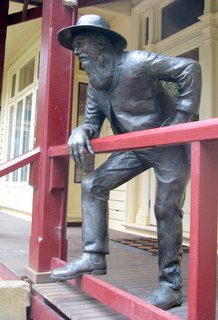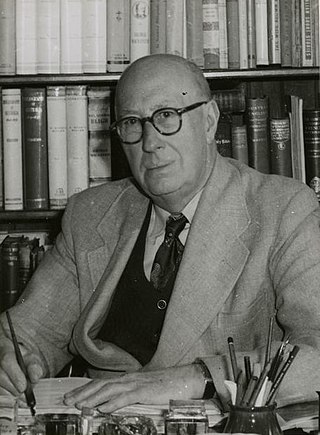
"The Man From Ironbark" is a poem by Australian bush poet Banjo Paterson. It is written in the iambic heptameter.
"Up The Country" is a popular poem by iconic Australian writer and poet Henry Lawson. It was first published in The Bulletin magazine on 9 July 1892, under the title "Borderland." Its publication marked the start of the Bulletin Debate, a series of poems by both Lawson and Andrew Barton "Banjo" Paterson asserting contrasting views of the true nature of life in the Australian bush.
The City Bushman is a poem by iconic Australian writer and poet Henry Lawson. It was first published in The Bulletin magazine on 6 August 1892, under the title In Answer to "Banjo", and Otherwise. It was the fourth work in the Bulletin Debate, a series of poems by both Lawson and Andrew Barton "Banjo" Paterson, and others, about the true nature of life in the Australian bush.
Pixie O'Harris was a Welsh-born Australian artist, newspaper, magazine and book illustrator, author, broadcaster, caricaturist and cartoonist, designer of book plates, sheet music covers and stationery, and children's hospital ward fairy-style mural painter. She became patron to Sydney's Royal Alexandra Hospital for Children in 1977.

Nancy May McDonald was an Australian poet and editor.

George Mackaness, born in Sydney, was a distinguished Australian educator, historian author, bibliographer and bibliophile.
"Bell-Birds" is a poem by Australian writer Henry Kendall that was first published in The Sydney Morning Herald on 25 November 1867.
Saltbush Bill is a humorous poem by Australian writer and poet Andrew Barton "Banjo" Paterson. It was first published in The Bulletin magazine on 15 December 1894, the Christmas issue of that publication.
The Old Whim Horse is a poem by Australian writer and poet Edward Dyson. It was first published in The Bulletin magazine on 30 July 1892, and later in the poet's collection Rhymes from the Mines and Other Lines (1896).
"The Last of His Tribe" is a poem by Australian writer Henry Kendall that was first published in The Sydney Morning Herald on 27 September 1864, under the title "Woonoona: The Last of His Tribe".

The Teams is a poem by Australian writer and poet Henry Lawson. It was first published in the Australian Town and Country Journal on 21 December 1889. It was later published in the poet's poetry collection In the Days When the World Was Wide and Other Verses in 1896.
T. Inglis Moore (1901–1978) was an Australian writer, anthologist and academic who was born in Camden, New South Wales.
"The Never-Never Country" (1901) is a poem by Australian poet Henry Lawson. It is also known by the title "The Never-Never Land".
"Faces in the Street" (1888) is a poem by Australian poet Henry Lawson.
"The Old Bush Road" (1892) (aka is a poem by Australian poet Jennings Carmichael.
"A Storm in the Mountains" (1856) is a poem by Australian poet Charles Harpur.
"The Fire at Ross's Farm" (1890) is a poem by Australian poet Henry Lawson.
"A Bushman's Song" (1892) is a poem by Australian poet A. B. Paterson.

Fair Girls and Grey Horses : With Other Verses (1898) is the first collection of poems by Scottish-Australian poet Will H. Ogilvie. It was published in hardback by The Bulletin in Sydney in 1898.
"The Roaring Days" (1889) is a poem by Australian poet Henry Lawson.




